badabooom
Harmless

Posts: 24
Registered: 10-8-2012
Location: running around the nucleus
Member Is Offline
Mood: bangin
|
|
Styphnic acid/ Lead Styphnate troubles
Hey guys,
I have read through all the topics relevant to my troubles but found no answers and thus started this new topic. The trouble that I am having may be
something simple but I just cannot get past it.
I use Rosco's synthesis (thanks Rosco) for preparing Styphnic acid, how ever when I dissolve the Resocinol the solution becomes a very dark blue to
purple colour and it does not change colour no matter how long I heat it, even at temperatures of 100C for 30 min it does not change colour. When I
Nitrate the mixture using Rosco's synth, the rest of the colour changes are on par. It gives nice pale yellow crystals when its filtered off. I use
reagent grade Resorcinol, technical H2SO4 98% conc and technical grade 68% HNO3. The 98% HNO3 I produce myself and its proper because it works for the
RDX synth.
The Styphnic acid burns as its supposed to, how ever when I use it to make Lead Styphnate it does not work. I use Methanol and Lead oxide to make the
Lead Styphnate, but it forms darker yellow, almost orange crystals that do not burn or detonate when dry, instead it just melts and turns black. What
am I doing wrong? I also tried the Powerlabs synth without any luck. Any help would be most appreciated.
|
|
|
watson.fawkes
International Hazard
    
Posts: 2793
Registered: 16-8-2008
Member Is Offline
Mood: No Mood
|
|
What are you doing? Without a full statement about what you're doing, don't expect
for someone to scry into your lab to fix your procedure.
|
|
|
badabooom
Harmless

Posts: 24
Registered: 10-8-2012
Location: running around the nucleus
Member Is Offline
Mood: bangin
|
|
You are correct, I should be more specific.
I wanted this to work on a small scale in order not to waste chemicals.
So I start off by adding 1g Resorcinol to 10ml 98% H2SO4 at a temperature of 20C. I then stirr the mixture to dissolve the Resorcinol in the H2SO4.
After 10-15 Sec the mixture becomes a very dark purple colour, almost black. Then I heat this mixture to 80C for 45min with occasional stirring. The
colour does not change.
After 45min I let the mixture cool down to 15 - 20 C which normally takes around 15 min in the Winter. Then I add the beaker to an ice bath as to
drop the temperature down to 5C. Then I add 15 ml of 60% HNO3 over the course of 1 hour as to not let the temperature spike and go over 30C, I then
leave the reaction for another 15 minutes after all the HNO3 has been added. At this point the solution has already frothed a few times and has
produced a yellowish/ orange solid in the beaker.
Now I heat the beaker at 60C for 2 Hours after which I let it cool down by itself overnight (8-10 hours). I then dump the entire solution into 300ml
distilled water @ 1C and wash the precipitate, then filter off.
For the Lead Styphnate I take the TNR from the filter paper still moist and dissolve it into 20ml Methanol and then add an equal amount of Lead Oxide
to the methanol solution. I stir and leave it for a day until all the Methanol has evaporated.
I hope this is all the info that is required as this is all I can think of at this stage. Thanks for pointing out the lack of info.
|
|
|
badabooom
Harmless

Posts: 24
Registered: 10-8-2012
Location: running around the nucleus
Member Is Offline
Mood: bangin
|
|
I just could not wait for someone to help me out so I went on and worked it out for myself . It turns out that there was nothing wrong with my TNR synth, the problem was getting the lead salt from it. I abandoned the Methanol
procedure because its too toxic and flammable anyhow (ironic considering the properties of the lead salt), I opted to use water in stead, good old
H2O. By simply dissolving the TNR and the Lead Oxide in boiling water and maintaining the temperature until there is only a yellow residue seemed to
do the trick. I found that by heating it at 90 - 110C for 10min produced a orange salt with superior properties to the yellow salt. . It turns out that there was nothing wrong with my TNR synth, the problem was getting the lead salt from it. I abandoned the Methanol
procedure because its too toxic and flammable anyhow (ironic considering the properties of the lead salt), I opted to use water in stead, good old
H2O. By simply dissolving the TNR and the Lead Oxide in boiling water and maintaining the temperature until there is only a yellow residue seemed to
do the trick. I found that by heating it at 90 - 110C for 10min produced a orange salt with superior properties to the yellow salt.
Just glad I got it working as I have spent a good amount of time getting it to work. I guess the whole concept of boiling Methanol on a gas flame
prevented my synth from being a success as I only ran the reaction at 70C on a water bath for 15 min. For 1g LS i use 30 ml of water as this provides
enough time for the reaction to take place as the water boils down.
I hope this helps someone somewhere with something sometime!
[Edited on 11-8-2012 by badabooom]
|
|
|
Hennig Brand
International Hazard
    
Posts: 1284
Registered: 7-6-2009
Member Is Offline
Mood: No Mood
|
|
The following quote is by chemoleo, from the thread "Styphnic acid and lead styphnate". That thread has some good information on your
topic of interest.
"Lead Styphnate from COPAE
Lead styphnate is commonly prepared by adding a solution of magnesium styphnate at 70° C to a well-stirred solution of lead acetate at 70° (I guess
nitrate should work too). A voluminous precipitate of the basic salt separates.
The mixture is stirred for 10 or 15 minutes; then dilute nitric acid is added with stirring to convert the basic to the normal salt, and the stirring
is continued while the temperature drops to about 30°. The product, which consists of reddish-brown, short, rhombic crystals, is filtered off, washed
with water, sieved through silk, and dried.
In terms of quantities - you could just add more Mg styphnate until no more precipitate occurs, or simply calculate the required amounts.
Mg- stypnate itself is prepared by adding magnesium oxide to a suspension of styphnic acid in water until a clear solution results and only a very
small portion of the
styphnic acid remains undissolved."
I have made lead styphnate in small quantity 3 times now I think, so I am not an expert. After reading your post I read a little and strained my
memory.
So, basically reiterating and adding a bit to what chemoleo said. Normally styphnic acid is converted to magnesium styphnate, quite often using
magnesium carbonate or magnesium oxide before conversion to lead styphnate. Magnesium styphnate is extremely soluble in water and very reactive with
the two common soluble lead salts, lead nitrate & lead acetate. There are also methods using the more common sodium hydroxide in place of a basic
magnesium salt to produce sodium styphnate, which is also very soluble in water and reactive with lead nitrate or lead acetate. The by-products of
both double decomposition reactions, magnesium nitrate/acetate and sodium nitrate/acetate, can be easily washed away from the lead styphnate product
because of their high solubility.
I think the lead oxide method is workable, but inferior to the magnesium styphnate and sodium styphnate methods using either lead nitrate or lead
acetate.
Here is a little solubility information taken from the wiki page titled "Solubility Table". Values given are in grams of solute per 100g of water at
20C. Refer to the wiki page for values at other temperatures.
Magnesium Nitrate....139
Magnesium Acetate...53.5
Sodium Nitrate.........87.6
Sodium Acetate........46.4
Lead (II) Nitrate........54.3
Lead (II) Acetate.......44.3
[Edited on 15-8-2012 by Hennig Brand]
"A risk-free world is a very dull world, one from which we are apt to learn little of consequence." -Geerat Vermeij
|
|
|
badabooom
Harmless

Posts: 24
Registered: 10-8-2012
Location: running around the nucleus
Member Is Offline
Mood: bangin
|
|
Wow thanks man! I have read up extensively on the magnesium styphnate version but Magnesium is not available to me, well actually it is if I put a
little effort in to acquire it. The thing is that I bought 500g Lead Oxide and want to make the best of it.
You mentioned that the Lead Oxide produces an inferior product, how is that? At this stage 50mg of LS produced via my method almost completely
destroys a 5x5cm (2x2 inc) piece of AL foil when heated unconfined. Is there a LS superior to that?
Also I did not know that its possible to make Sodium Styphnate from Sodium Nitrate, I have over 25Kg (55lbs) of it!
Thanks again for your contribution to my thread and sharing your ideas.
|
|
|
Hennig Brand
International Hazard
    
Posts: 1284
Registered: 7-6-2009
Member Is Offline
Mood: No Mood
|
|
You can use sodium hydroxide, or probably sodium carbonate or bicarbonate even to produce sodium styphnate, you don't necessarily need magnesium
carbonate or oxide. I also didn't say your product was necessarily inferior, but I did say that I thought the method was. Actually, now that you
mention it, I think it would be easier to get a product of higher purity using the magnesium styphnate or sodium styphnate methods.
BTW, the sodium nitrate is a by-product of the double decomposition reaction between sodium styphnate and lead nitrate.
Sodium Styphnate + Lead Nitrate ------> Lead Styphnate + Sodium Nitrate
The lead styphnate produced is actually basic lead styphnate, a little dilute HNO3 is added to convert is to normal lead styphnate usually.
"A risk-free world is a very dull world, one from which we are apt to learn little of consequence." -Geerat Vermeij
|
|
|
badabooom
Harmless

Posts: 24
Registered: 10-8-2012
Location: running around the nucleus
Member Is Offline
Mood: bangin
|
|
I will give that a try this weekend and post some pics of the synth so other could benefit. I shall be using the Sodium Hydroxide method as this is
plenty full in my lab. Also out of interest I shall compare the Lead Oxide product with the Sodium Hydroxide product and post my results. And for the
Sodium Nitrate as a byproduct, that's just great! like I need more of that!
Thanks for your valuable inputs once again.
|
|
|
Hennig Brand
International Hazard
    
Posts: 1284
Registered: 7-6-2009
Member Is Offline
Mood: No Mood
|
|
From wiki page:
Solubility of lead oxide in water
0.00504 g/100 mL (alpha form)
0.01065 g/100 mL (beta form)
The solubility data I posted for lead nitrate and lead acetate above was 54.3 g/100g water and 44.3 g/100g water respectively (at 20C).
Lead (II) Oxide can be easily converted to either lead nitrate or lead acetate by adding nitric acid to produce the nitrate, or acetic acid to produce
the acetate. The basic overall equations are as follows.
PbO + 2HNO3 -------> Pb(NO3)2 + H2O
PbO + 2 CH3COOH ------> Pb(CH3COO)2 + H2O
"A risk-free world is a very dull world, one from which we are apt to learn little of consequence." -Geerat Vermeij
|
|
|
badabooom
Harmless

Posts: 24
Registered: 10-8-2012
Location: running around the nucleus
Member Is Offline
Mood: bangin
|
|
the two main objectives of the test is going to be the comparison of the final product with regards to product purity and performance and then also
yields and costs with respect to each.
I will opt for the lead Nitrate method rather than the acetate as the 68 % HNO3 is abundantly available (75L) (75L)
|
|
|
badabooom
Harmless

Posts: 24
Registered: 10-8-2012
Location: running around the nucleus
Member Is Offline
Mood: bangin
|
|
I think having taken into account that you said the basic lead styphnate must be converted into the normal lead styphnate by the addition of a little
dilute HNO3, taking into consideration the equation; PbO + 2HNO3 -------> Pb(NO3)2 + H2O I could have a little excess HNO3 and do the lead nitrate
in situ.
What are your thoughts on this?
|
|
|
caterpillar
Hazard to Others
  
Posts: 472
Registered: 8-1-2012
Member Is Offline
Mood: No Mood
|
|
Two remarks. As I read in a solid russian book on primaries, lead nitrate must be used in aforementioned synthesis, not lead acetate (I cannot say
why, but this recommendation remember well). The second thing- lead nitrate can be prepared by heating of lead oxide II with AN without nitric acid.
Women are more perilous sometimes, than any hi explosive.
|
|
|
badabooom
Harmless

Posts: 24
Registered: 10-8-2012
Location: running around the nucleus
Member Is Offline
Mood: bangin
|
|
Thanks for your input. I would settle for the HNO3+PbO method of producing Lead Nitrate because there is surplus HNO3 available. But its very good to
know that there are so many other ways for members that do not have that privilege.
Also to all other members reading this and interested in the synth, I am under no circumstances making a how to guide or "recipe" because I am not a
chef nor am I the author of a "cookbook". I am doing this experiment for the people that are interested in the science behind it and not for the
person that's planning their next 4th of July bang.
I will post a detailed synth with pics and the results of the product produced. This will only be a small scale experiment focusing only on Lead
Styphnate.
Thank you to all members that have contributed so far, everyone's input is highly valued.
[Edited on 17-8-2012 by badabooom]
|
|
|
Hennig Brand
International Hazard
    
Posts: 1284
Registered: 7-6-2009
Member Is Offline
Mood: No Mood
|
|
Quote: Originally posted by caterpillar  | | Two remarks. As I read in a solid russian book on primaries, lead nitrate must be used in aforementioned synthesis, not lead acetate (I cannot say
why, but this recommendation remember well). The second thing- lead nitrate can be prepared by heating of lead oxide II with AN without nitric acid.
|
I think both lead nitrate and lead acetate can be used. There are many references showing lead acetate being used to produce lead styphnate.
The COPAE decribes lead acetate being used to produce lead styphnate.
I posted this pdf file last year in the "Styphnic acid and lead styphnate" thread (go there to view). It details production of normal lead styphnate
from both lead nitrate and lead acetate. The two products, using the methods described in the report, are apparently a bit different though.
Attachment: Lead Styphnate for military primers.pdf (786kB)
There are many more references as well.
That being said, I have only ever used lead nitrate to make lead styphnate.
[Edited on 17-8-2012 by Hennig Brand]
"A risk-free world is a very dull world, one from which we are apt to learn little of consequence." -Geerat Vermeij
|
|
|
badabooom
Harmless

Posts: 24
Registered: 10-8-2012
Location: running around the nucleus
Member Is Offline
Mood: bangin
|
|
Below are some of the pics taken during the Synth
TNR
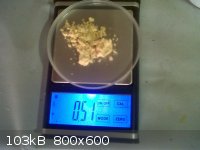
Sodium Styphnate/Lead Nitrate after stirring
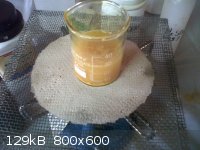
Some LS made by the Lead Oxide method
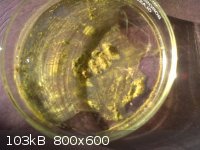
Here there are two samples that are being compared, you can clearly see that the Sodium Styphnate/ Lead Nitrate has produced the purest product. The
lead Oxide method left some TNR in the mixture. None where purified for the purpose of seeing which method produced the purest form.

5mg was ignited unconfined on a piece of heavy Al foil. Both samples performed more or less the same so only one sample was used for the photo.
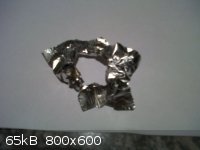
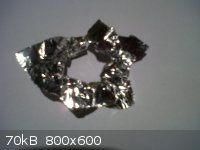
I hope that this answers some questions. Fire away with the comments or questions.....
|
|
|
badabooom
Harmless

Posts: 24
Registered: 10-8-2012
Location: running around the nucleus
Member Is Offline
Mood: bangin
|
|
Why is it that after I had the experiments that no one has any comments or questions? Come on my fellow enthusiasts, this post is our oyster!
|
|
|
badabooom
Harmless

Posts: 24
Registered: 10-8-2012
Location: running around the nucleus
Member Is Offline
Mood: bangin
|
|
Sadly it seems that there is not much interest in Lead Styphnate. I will thus only post the synth details if I see some interested people, otherwise
its just a waste of time and effort to type millions of words and no one to read it.
|
|
|
Kalium
Harmless

Posts: 33
Registered: 21-6-2012
Location: Australia
Member Is Offline
Mood: No Mood
|
|
Quote: Originally posted by badabooom  | Sadly it seems that there is not much interest in Lead Styphnate. I will thus only post the synth details if I see some interested people, otherwise
its just a waste of time and effort to type millions of words and no one to read it.
|
Wait, this is what I've been looking for. I'd love to see your method. 
|
|
|
Rosco Bodine
Banned
Posts: 6370
Registered: 29-9-2004
Member Is Offline
Mood: analytical
|
|
http://www.sciencemadness.org/talk/viewthread.php?tid=2827#p...
|
|
|